This is a list of aviation-related events during the 18th century :
Andreani is an Italian surname, derived from Andrea (Andrew). Notable people with the surname include:
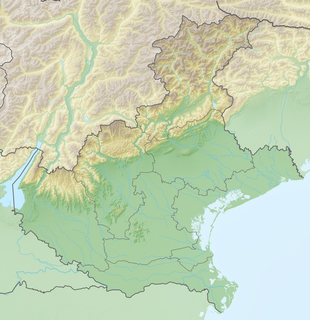
Villa Barbaro, also known as the Villa di Maser, is a large villa at Maser in the Veneto region of northern Italy. It was designed and built by the Italian Renaissance architect Andrea Palladio, with frescos by Paolo Veronese and sculptures by Alessandro Vittoria, for Daniele Barbaro, Patriarch of Aquileia and ambassador to Queen Elizabeth I of England and his brother Marcantonio, an ambassador to King Charles IX of France. The villa was added to the list of World Heritage Sites by UNESCO in 1996.

Brugherio is a comune (municipality) in the Province of Monza and Brianza in the Italian region Lombardy, located about 10 kilometres northeast of Milan. It was established December 9, 1866 unifying the suppressed municipalities of Baraggia, San Damiano and Moncucco, together with the villages of Bindellera, Cesena, Gelosa, San Paolo, Torazza, Occhiate and Increa.

Giocondo Albertolli was a Swiss-born architect, painter, and sculptor who was active in Italy during the Neoclassical period.
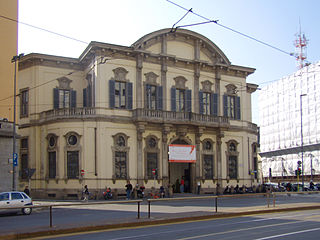
Palazzo Sormani is a historic building of Milan, Italy, and the seat of the central public library of Milan. It is located at number 6 in Corso di Porta Vittoria, in the Zone 1 administrative division of the city.
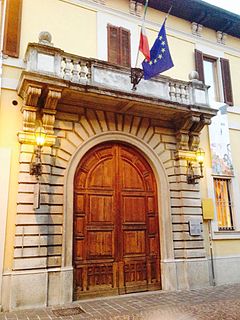
The Palazzo Ghirlanda-Silva is a patrician building in the old town of Brugherio, Italy. Built in the first half of the nineteenth century, it now houses the public library. It has an area of 1,992 m2 (21,440 sq ft), of which 1,407 m2 (15,140 sq ft) are used for library services, with the remaining space providing an exhibition room, an auditorium and offices.

Saint Lucius in Brugherio, Italy, is a small church dedicated to Saint Lucius in the grounds of the Villa Sormani. First located in Lugano, Switzerland, where it was a Franciscan chapel, the building was disassembled and transported to Brugherio where its reconstruction was completed 17 years later.

Villa Scotti-Cornaglia-Noseda-Bertani, commonly known as Villa Fiorita, is a building in Lombardy, Italy, where the Brugherio Comune's headquarters are housed.
Villa Brivio is a 19th-century building in the Baraggia district of Brugherio, Italy. Owned by the municipality, it houses a residential center specializing in psychiatric therapy.
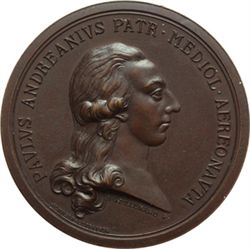
Paolo Andreani was an Italian who made the first balloon flight over Italian soil. He also made an exploration around the Great Lakes in North America.

Saint Ambrose is a small church which is an annex to the farmhouse that takes its name from it, in Brugherio, Italy.

Villa Tizzoni Ottolini is located in the architectural complex of Cascina Increa, in southeast Brugherio, Italy.

Cascina Sant'Ambrogio is the oldest among the farmhouses in Brugherio, Italy. It is annexed to Saint Ambrose Church from which it takes its name.

Cassina Baraggia is a hamlet of Brugherio's municipality, which until 1866 was a separate municipality.

Moncucco was an autonomous Italian municipality until March 30, 1871, when due to a royal decree it became a hamlet of the town of Brugherio, established in 1866. The actual village is located south of Brugherio, along the road that leads from Milan to Vimercate.
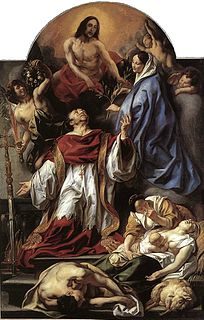
There are three plague crosses in Brugherio, in the province of Monza and Brianza in Lombardy, in northern Italy. They were erected after the plague that struck Monza and its surrounding area in 1576. The crosses are three that remain of four that marked where there were four altars used to celebrate religious services during the plague. The plague of 1576 was in fact called "the plague of Saint Charles", given the Bishop's closeness to those affected. Information about the plague can be found in the Bishop of Milan, Saint Charles Borromeo's notes.

Villa Somaglia-Balconi is a residential complex located in Brugherio, consisting of a main house and some accompanying buildings, which are separated from the original structure of the villa by Via Marsala, which leads from Moncucco to Carugate.
The old farmhouses of Brugherio were agricultural structures typical of the Po-Valley in Lombardy, which gave its name to the surrounding areas as well, roughly corresponding to fractional towns in which Brugherio was divided. The union of the various small rural municipalities in which the territory was fragmented gave birth in 1866 to the municipality of Brugherio. Some are still visible: Bindellera, Casecca, Cattoni, Comolli, Dorderio, Guzzina, Increa, Modesta, Moia, Occhiate, Pareana, San Cristoforo, Sant'Ambrogio, San Paolo and Torazza.
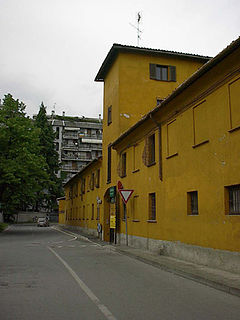
Cascina Guzzina is a farmhouse located in the southern part of Brugherio, on the border with Cologno Monzese. The name comes from gussetta, which formerly referred to the cocoon of the silkworm, whose breeding was widespread in the area. Agricultural complexes known as "agricultural courts", which once held prolific agricultural activity, are now civilian residences and businesses.

















